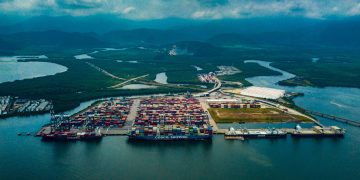According to T&E, nearly a third of global shipping could run on biofuels in 2030, up from less than 1% today, posing a serious climate problem.
Plans being drafted at the IMO risk creating a huge new market for deforestation-driving biofuels like palm and soy, while also putting pressure on vegetable oil prices. The study by Cerulogy on behalf of T&E called ‘Full steam ahead? Environmental impacts of expanding the supply of maritime biofuels for the International Maritime Organisation targets‘ shows that palm and soy oil would likely make up nearly two-thirds of the biodiesel used to power the shipping industry in 2030 as they represent the cheapest fuels to comply.
This poses a serious climate problem, warns T&E, as palm and soy are responsible for two to three times more carbon emissions than even the dirtiest shipping fuels today, once deforestation and land clearance are taken into account. Some of these issues have led countries such as Norway, France, the Netherlands and others to restrict or ban biofuels produced from feedstocks such as palm or soy. In addition, regulations such as FuelEU Maritime and RefuelEU exclude the use of feed- and food-based biofuels.
T&E pointed out that the fuel-intensive shipping industry would need vast amounts of farmland. 34 million hectares in 2030 – the total area of Germany – will be needed to produce enough crops to meet the increased biofuels demand from the shipping industry.
 In addition, this could have serious impacts on food supplies. Land that could be used for farming would need to be converted to growing biofuel crops, while burning vegetable oil in ships will deprive supermarkets of a staple food item. 300 mn bottles of vegetable oil could be diverted to powering ships every day in 2030, according to T&E’s analysis.
In addition, this could have serious impacts on food supplies. Land that could be used for farming would need to be converted to growing biofuel crops, while burning vegetable oil in ships will deprive supermarkets of a staple food item. 300 mn bottles of vegetable oil could be diverted to powering ships every day in 2030, according to T&E’s analysis.
What are ILUC emissions and why do they matter?
ILUC is the acronym for indirect land-use change, and refers to the GHG emissions resulting from the displacement of agricultural production – for food and feed purposes – when land is used instead for biofuel crops. Expanding land for crop planting often occurs at the expense of carbon-rich environments (e.g. natural lands, forests) resulting in a loss of carbon stocks. As a consequence, a significant quantity of GHG emissions stored in the vegetation and soil is emitted in the atmosphere.
ILUC emissions are an important variable to consider when assessing the GHG profile of biofuels, as some are associated with high-ILUC emission factors that can negate their overall GHG savings. ILUC emission factors can be assessed and quantified via modelling, and have already been included in LCA regulatory frameworks, including at the global level. For example, the CORSIA LCA emission values include ILUC factors to determine the GHG impact of aviation’s alternative fuels. Similarly, the EU Renewable Energy Directive (RED) acknowledges the impact of ILUC emissions and sets a maximum threshold for relying on food and feed crop-based biofuels.

Fueling cargo ships with deforestation is a terrible idea. Burning crops for fuel is bad for the planet and bad for global food security. The IMO should consider the climate impact of bad biofuels to avoid doing more harm than good.
…said Constance Dijkstra, Shipping Manager, T&E.
GHG emissions impact from biodiesel
Under the unrestricted scenario, palm and soybean oil could make up 60% of the global biodiesel feedstock mix by 2030, with rapeseed oil making 20% and the rest being fulfilled by smaller quantities of UCO (10%), animal fat (8%), and cellulosic residue (2%). From 2035 until 2040, the share of palm and soybean oil reduces, eventually reaching 15% of the global biodiesel feedstock share by 2040. This is mainly due to the emissions factors assigned to these feedstocks, which remain the same across the period (53 gCO2e/MJ for palm oil and 48 gCO2e/MJ for soybean oil), being too high for operators to meet GFS targets.
Due to their limited availability, waste-based feedstock quantities remain relatively constant across the years, except for a small increase of cellulosic feedstocks. Most importantly from 2035 onward, the share of hypothetical biodiesel feedstock increases significantly up 52% by 2040. This is due to the uncertainty of where those feedstocks could originate from if these had to be bio-based.
The large share of palm and soybean oil under scenario 1 is driven by their affordability compared to any other types of oils, whether it is other vegetable oils or waste oils. Such a large share of palm and soybean oil would have negative consequences for climate change.
In fact, Cerulogy estimates that by 2030 emissions from palm and soybean oil combined to other feedstocks could result in GHG emissions 87% higher than if these ships relied on fossil fuels instead. Those emissions would still be 21% higher than fossil fuels by 2035, and would only decrease significantly by 2040.
Furthermore, shipping companies like MSC and CMA-CGM have invested in so-called waste biofuels like used cooking oil (UCO) and animal fats. But waste biofuels will likely be able to cover just a small proportion of shipping’s projected biofuels demand as their availability is limited.
Shipping companies including the German shipping giant Hapag-Lloyd and a number of NGOs called on the IMO to exclude unsustainable biofuels from its list of green alternatives to traditional fossil fuels.
T&E calls on the IMO to agree on a clear definition of what constitutes a ‘zero’ and ‘near zero’ emission fuel, to exclude deforestation-linked biofuels, cap food-based biofuels and to incentivise green e-fuels made from green hydrogen.
Policy recommendations:
- Consider excluding high-ILUC crop-based biofuels from complying under MARPOL ANNEX VI regulations or directly within the LCA framework. This could be operationalised by, for example, assigning quantifiable ILUC emission factors or as a fall-back option the well-to-wake GHG values of the least favourable fossil fuels. Alternatively, consider capping the use of food-crops for biofuels production under MARPOL Annex VI or through national legislation in complying with GFS.
- Establish early and dedicated incentives to favour the production and uptake of green e-fuels through mechanisms such as reward factors under the GFS. In the case of funds dedicated specifically to alternative fuels, ensure that green e-fuels are prioritized over biofuels produced from waste material such as UCO or animal fat which are not scalable alternatives.
- When defining a zero and near-zero (ZNZ) emission fuels, agree on stringent GHG intensity thresholds that will promote the uptake of green e-fuels: at least 90% WtW CO2e emissions reduction relative to the fossil fuel baseline from 2030 onwards, or a maximum of 10 gCO2e/MJ of energy GHG intensity; at least 95% WtW CO2e emissions reduction relative to the fossil fuel baseline from 2040 onwards, or a maximum of 5 gCO2e/MJ energy GHG intensity; 100% WtW CO2e emissions reduction from 2050 onwards.


































































